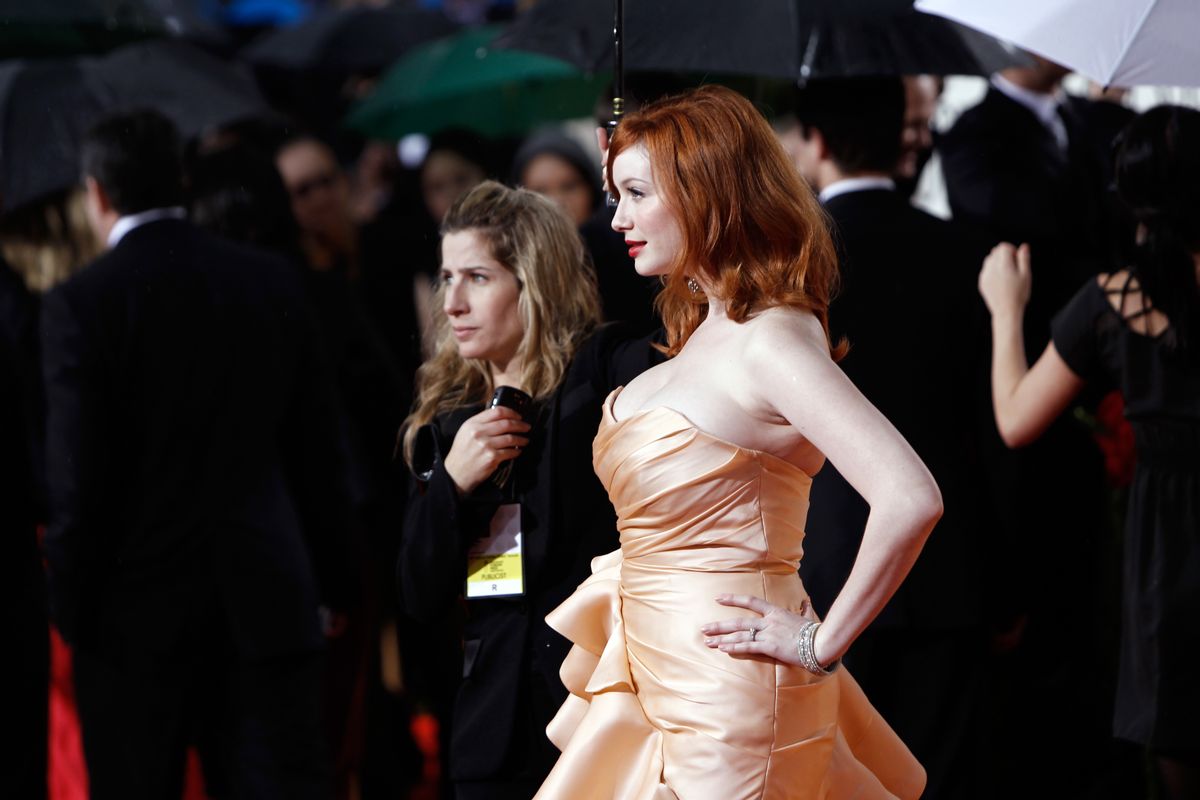When I spotted Gothamist's headline, "NYT Distorts Image of Christina Hendricks, Calls Her 'Big,'" I involuntarily groaned. "Really, NY Times?" I thought. "Did you have to pull the combination weight-related low blow/Photoshop disaster on one of my favorite actresses?" And I wasn't alone. Bloggers at Jezebel and Flavorpill echoed Gothamist's "WTF," lamenting that we can't discuss anything about the "Mad Men" actress but her curves and reminding us that the NY Times post's author, Cathy Horyn, who has her own history of weight issues, could stand to be more sensitive about her descriptions.
I see both points, but when I gave Horyn's post a fair read, my reaction was somewhat different. First of all, I have a hard time believing the Times' distorted photo was anything more than the "processing" mistake Horyn claims it was. It's not like the goal of the piece, which appeared on NYTimes.com's T magazine blog, is meant to convince us that Hendricks is a heifer. Rather, it's a quick take on how uninspired the night's red carpet dresses were. Here's the offending text, part of a list of which outfits didn't do it for Horyn: "Not pretty Christina Hendricks in Christian Siriano’s exploding ruffle dress. (As one stylist said, 'You don’t put a big girl in a big dress. That’s rule number one.')"
First of all, the quote makes it clear that Horyn isn't the one calling Hendricks "big"; it was an anonymous stylist. Of course, it is Horyn who used the snarky quote to add zing to her piece. Horyn wouldn't be the first writer to hide behind someone else's quotation marks to circumvent actually saying such a remark herself, but to be fair, Horyn's descriptor was "pretty."
It's also significant that the stylist used the word "big" rather than "fat." Personally, I wouldn't use either word in reference to Hendricks. But it's certainly true that part of what distinguishes Hendricks is her curvy body shape and unapologetic presence. She's 5'8" in an industry where even some leading men (cough cough, Tom Cruise) are shorter than that. So, compared to the clients the stylist may be used to dressing -- size-2 cheerleaders hoping to find outfits that make them look even smaller -- Hendricks probably is "big."
And that's where I think the Horyn/Hendricks debacle actually says something about the way we see women's bodies in the media. The range of body types we're used to seeing on TV and in the movies is so ridiculously narrow that we don't even have the vocabulary to discuss a size-10 woman without causing offense. Case in point: Gothamist was also bothered by another post about Golden Globes fashion, also on the T magazine blog, in which writer Andy Port points out that some leading ladies walked the red carpet "sporting sexier curves." Directing readers to Jennifer Aniston, Kate Hudson and Courteney Cox's apparently larger upper arms, Port writes, "Instead of a Barbie-doll circumference, there was suddenly, amazingly, a womanly roundness to their frames. More Marilyn than Twiggy, that’s for sure." Last night, a friend tweeted the link to Port's piece with the announcement that it was enough to make her boycott the Times.
But I'm not sure what's so outrageous about writing positively about women's weight gain. If the fashion press must obsess over lady stars' bodies -- and let's face it, that preoccupation isn't going anywhere soon -- then I'd rather read flattering comparisons to Marilyn Monroe that include words like "sexy" than a parade of shaming tabloid headlines. Even the TV Guide channel's hideously snarky fashion police were glowing in their praise for "Precious" star Gabourey Sibide. (Though frankly, I part with them on this. While I found the color beautiful, I hated the cut. Undoubtedly Gabourey is this year's "fat woman we love," and heaping praise on her may help salve the self-hatred for those whose business is cutting others down for their minor shortcomings. But that's another post.)
Ultimately, our indignant reactions to both blog posts seem to have more to do with our learned negative associations with words like "big" and "round." To begin changing media perceptions and improving our own body image, we need to stop taking those words as insults -- especially when writers like Port are using them in a positive light (a subject about which Broadsheet's Kate Harding has written frequently, and eloquently). Why is it impossible for us to imagine that a woman who can fairly be called "big" -- not Christina Hendricks, who is still smaller than the average American lady -- might also be incredibly, ravishingly beautiful?



Shares